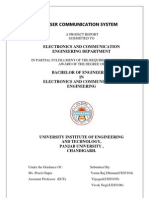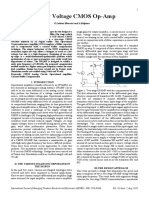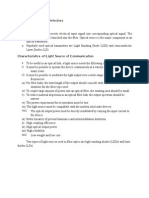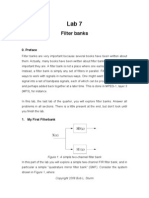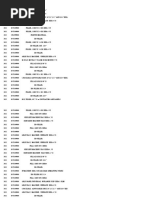Impedance Matching and The Smith Chart: The Fundamentals
Impedance Matching and The Smith Chart: The Fundamentals
Uploaded by
KanwalAslamCopyright:
Available Formats
Impedance Matching and The Smith Chart: The Fundamentals
Impedance Matching and The Smith Chart: The Fundamentals
Uploaded by
KanwalAslamOriginal Title
Copyright
Available Formats
Share this document
Did you find this document useful?
Is this content inappropriate?
Copyright:
Available Formats
Impedance Matching and The Smith Chart: The Fundamentals
Impedance Matching and The Smith Chart: The Fundamentals
Uploaded by
KanwalAslamCopyright:
Available Formats
Click here for an overview of the wireless
components used in a typical radio
transceiver.
Maxim > Design Support > Technical Documents > Tutorials > Wireless and RF > APP 742
Keywords: smith chart, RF, impedance matching, transmission line
TUTORIAL 742
Impedance Matching and the Smith Chart: The
Fundamentals
Jul 22, 2002
Abstract: Tutorial on RF impedance matching using the Smith chart. Examples are shown plotting
reflection coefficients, impedances and admittances. A sample matching network of the MAX2472 is
designed at 900MHz using graphical methods.
Tried and true, the Smith chart is still the basic tool for determining transmission-line impedances.
When dealing with the practical implementation of RF applications,
there are always some nightmarish tasks. One is the need to match
the different impedances of the interconnected blocks. Typically
these include the antenna to the low-noise amplifier (LNA), power-
amplifier output (RFOUT) to the antenna, and LNA/VCO output to
mixer inputs. The matching task is required for a proper transfer of
signal and energy from a "source" to a "load."
At high radio frequencies, the spurious elements (like wire
inductances, interlayer capacitances, and conductor resistances)
have a significant yet unpredictable impact on the matching
network. Above a few tens of megahertz, theoretical calculations and simulations are often insufficient.
In-situ RF lab measurements, along with tuning work, have to be considered for determining the proper
final values. The computational values are required to set up the type of structure and target component
values.
There are many ways to do impedance matching, including:
Computer simulations: Complex but simple to use, as such simulators are dedicated to differing
design functions and not to impedance matching. Designers have to be familiar with the multiple
data inputs that need to be entered and the correct formats. They also need the expertise to find the
useful data among the tons of results coming out. In addition, circuit-simulation software is not pre-
installed on computers, unless they are dedicated to such an application.
Manual computations: Tedious due to the length ("kilometric") of the equations and the complex
nature of the numbers to be manipulated.
Instinct: This can be acquired only after one has devoted many years to the RF industry. In short,
this is for the super-specialist.
Smith chart: Upon which this article concentrates.
The primary objectives of this article are to review the Smith chart's construction and background, and to
summarize the practical ways it is used. Topics addressed include practical illustrations of parameters,
Page 1 of 18
such as finding matching network component values. Of course, matching for maximum power transfer is
not the only thing we can do with Smith charts. They can also help the designer with such tasks as
optimizing for the best noise figures, ensuring quality factor impact, and assessing stability analysis.
Figure 1. Fundamentals of impedance and the Smith chart.
A Quick Primer
Before introducing the Smith chart utilities, it would be prudent to present a short refresher on wave
propagation phenomenon for IC wiring under RF conditions (above 100MHz). This can be valid for
contingencies such as RS-485 lines, between a PA and an antenna, between an LNA and a
downconverter/mixer, and so forth.
It is well known that, to get the maximum power transfer from a source to a load, the source impedance
must equal the complex conjugate of the load impedance, or:
R
S
+jX
S
=R
L
- jX
L
Figure 2. Diagram of R
S
+ jX
S
= R
L
- jX
L
.
For this condition, the energy transferred from the source to the load is maximized. In addition, for
efficient power transfer, this condition is required to avoid the reflection of energy from the load back to
the source. This is particularly true for high-frequency environments like video lines and RF and
microwave networks.
What It Is
A Smith chart is a circular plot with a lot of interlaced circles on it. When used correctly, matching
Page 2 of 18
impedances, with apparent complicated structures, can be made without any computation. The only effort
required is the reading and following of values along the circles.
The Smith chart is a polar plot of the complex reflection coefficient (also called gamma and symbolized
by ). Or, it is defined mathematically as the 1-port scattering parameter s or s
11
.
A Smith chart is developed by examining the load where the impedance must be matched. Instead of
considering its impedance directly, you express its reflection coefficient
L
, which is used to characterize
a load (such as admittance, gain, and transconductance). The
L
is more useful when dealing with RF
frequencies.
We know the reflection coefficient is defined as the ratio between the reflected voltage wave and the
incident voltage wave:
Figure 3. Impedance at the load.
The amount of reflected signal from the load is dependent on the degree of mismatch between the
source impedance and the load impedance. Its expression has been defined as follows:
Because the impedances are complex numbers, the reflection coefficient will be a complex number as
well.
In order to reduce the number of unknown parameters, it is useful to freeze the ones that appear often
and are common in the application. Here Z
0
(the characteristic impedance) is often a constant and a real
industry normalized value, such as 50, 75, 100, and 600. We can then define a normalized load
impedance by:
With this simplification, we can rewrite the reflection coefficient formula as:
Here we can see the direct relationship between the load impedance and its reflection coefficient.
Unfortunately, the complex nature of the relation is not useful practically, so we can use the Smith chart
as a type of graphical representation of the above equation.
To build the chart, the equation must be rewritten to extract standard geometrical figures (like circles or
stray lines).
Page 3 of 18
First, equation 2.3 is reversed to give:
and
By setting the real parts and the imaginary parts of equation 2.5 equal, we obtain two independent, new
relationships:
Equation 2.6 is then manipulated by developing equations 2.8 through 2.13 into the final equation, 2.14.
This equation is a relationship in the form of a parametric equation (x - a) +(y - b) =R in the complex
plane (r, i) of a circle centered at the coordinates [r/(r + 1), 0] and having a radius of 1/(1 + r).
See Figure 4a for further details.
Page 4 of 18
Figure 4a. The points situated on a circle are all the impedances characterized by a same real
impedance part value. For example, the circle, r = 1, is centered at the coordinates (0.5, 0) and has a
radius of 0.5. It includes the point (0, 0), which is the reflection zero point (the load is matched with the
characteristic impedance). A short circuit, as a load, presents a circle centered at the coordinate (0, 0)
and has a radius of 1. For an open-circuit load, the circle degenerates to a single point (centered at 1, 0
and with a radius of 0). This corresponds to a maximum reflection coefficient of 1, at which the entire
incident wave is reflected totally.
When developing the Smith chart, there are certain precautions that should be noted. These are among
the most important:
All the circles have one same, unique intersecting point at the coordinate (1, 0).
The zero circle where there is no resistance (r = 0) is the largest one.
The infinite resistor circle is reduced to one point at (1, 0).
There should be no negative resistance. If one (or more) should occur, we will be faced with the
possibility of oscillatory conditions.
Another resistance value can be chosen by simply selecting another circle corresponding to the new
value.
Back to the Drawing Board
Moving on, we use equations 2.15 through 2.18 to further develop equation 2.7 into another parametric
equation. This results in equation 2.19.
Again, 2.19 is a parametric equation of the type (x - a) + (y - b) = R in the complex plane (r, i) of a
circle centered at the coordinates (1, 1/x) and having a radius of 1/x.
See Figure 4b for further details.
Page 5 of 18
Figure 4b. The points situated on a circle are all the impedances characterized by a same imaginary
impedance part value x. For example, the circle = 1 is centered at coordinate (1, 1) and has a radius
of 1. All circles (constant x) include the point (1, 0). Differing with the real part circles, can be positive
or negative. This explains the duplicate mirrored circles at the bottom side of the complex plane. All the
circle centers are placed on the vertical axis, intersecting the point 1.
Get the Picture?
To complete our Smith chart, we superimpose the two circles' families. It can then be seen that all of the
circles of one family will intersect all of the circles of the other family. Knowing the impedance, in the
form of r +jx, the corresponding reflection coefficient can be determined. It is only necessary to find the
intersection point of the two circles corresponding to the values r and x.
It's Reciprocating Too
The reverse operation is also possible. Knowing the reflection coefficient, find the two circles intersecting
at that point and read the corresponding values r and on the circles. The procedure for this is as
follows:
Determine the impedance as a spot on the Smith chart.
Find the reflection coefficient () for the impedance.
Having the characteristic impedance and , find the impedance.
Convert the impedance to admittance.
Find the equivalent impedance.
Find the component values for the wanted reflection coefficient (in particular the elements of a
matching network, see Figure 7).
To Extrapolate
Because the Smith chart resolution technique is basically a graphical method, the precision of the
solutions depends directly on the graph definitions. Here is an example that can be represented by the
Smith chart for RF applications:
Page 6 of 18
Example: Consider the characteristic impedance of a 50 termination and the following impedances:
Z
1
= 100 + j50 Z
2
= 75 - j100 Z
3
= j200 Z
4
= 150
Z
5
= (an open circuit) Z
6
=0 (a short circuit) Z
7
= 50 Z
8
= 184 - j900
Then, normalize and plot (see Figure 5). The points are plotted as follows:
z
1
=2 +j z
2
=1.5 - j2 z
3
=j4 z
4
=3
z
5
=8 z
6
=0 z
7
=1 z
8
=3.68 - j18
For Larger Image (PDF, 502K)
Figure 5. Points plotted on the Smith chart.
It is now possible to directly extract the reflection coefficient on the Smith chart of Figure 5. Once the
impedance point is plotted (the intersection point of a constant resistance circle and of a constant
reactance circle), simply read the rectangular coordinates projection on the horizontal and vertical axis.
This will give r, the real part of the reflection coefficient, and i, the imaginary part of the reflection
coefficient (see Figure 6).
It is also possible to take the eight cases presented in the example and extract their corresponding
Page 7 of 18
directly from the Smith chart of Figure 6. The numbers are:
1
=0.4 +0.2j
2
=0.51 - 0.4j
3
=0.875 +0.48j
4
=0.5
5
=1
6
=-1
7
=0
8
=0.96 - 0.1j
Figure 6. Direct extraction of the reflected coefficient , real and imaginary along the X-Y axis.
Working with Admittance
The Smith chart is built by considering impedance (resistor and reactance). Once the Smith chart is built,
it can be used to analyze these parameters in both the series and parallel worlds. Adding elements in a
series is straightforward. New elements can be added and their effects determined by simply moving
along the circle to their respective values. However, summing elements in parallel is another matter. This
requires considering additional parameters. Often it is easier to work with parallel elements in the
admittance world.
We know that, by definition, Y = 1/Z and Z = 1/Y. The admittance has been expressed in mhos or
-1
,
though now is expressed as siemens, or S. And, as Z is complex, Y must also be complex.
Therefore, Y =G +jB (2.20), where G is called "conductance" and B the "susceptance" of the element.
It's important to exercise caution, though. By following the logical assumption, we can conclude that G =
1/R and B =1/X. This, however, is not the case. If this assumption is used, the results will be incorrect.
When working with admittance, the first thing that we must do is normalize y =Y/Y
0
. This results in y =
g +jb. So, what happens to the reflection coefficient? By working through the following:
Page 8 of 18
It turns out that the expression for G is the opposite, in sign, of z, and (y) = -(z).
If we know z, we can invert the signs of and find a point situated at the same distance from (0, 0), but
in the opposite direction. This same result can be obtained by rotating an angle 180 around the center
point (see Figure 7).
Figure 7. Results of the 180 rotation.
Of course, while Z and 1/Y do represent the same component, the new point appears as a different
impedance (the new value has a different point in the Smith chart and a different reflection value, and so
forth). This occurs because the plot is an impedance plot. But the new point is, in fact, an admittance.
Therefore, the value read on the chart has to be read as siemens.
Although this method is sufficient for making conversions, it doesn't work for determining circuit resolution
when dealing with elements in parallel.
The Admittance Smith Chart
In the previous discussion, we saw that every point on the impedance Smith chart can be converted into
its admittance counterpart by taking a 180 rotation around the origin of the complex plane. Thus, an
admittance Smith chart can be obtained by rotating the whole impedance Smith chart by 180. This is
extremely convenient, as it eliminates the necessity of building another chart. The intersecting point of all
the circles (constant conductances and constant susceptances) is at the point (-1, 0) automatically. With
that plot, adding elements in parallel also becomes easier. Mathematically, the construction of the
admittance Smith chart is created by:
then, reversing the equation:
Page 9 of 18
Next, by setting the real and the imaginary parts of equation 3.3 equal, we obtain two new, independent
relationships:
By developing equation 3.4, we get the following:
which again is a parametric equation of the type (x - a) +(y - b) =R (equation 3.12) in the complex
plane (r, i) of a circle with its coordinates centered at [-g/(g + 1), 0] and having a radius of 1/(1 + g).
Furthermore, by developing equation 3.5, we show that:
which is again a parametric equation of the type (x - a) +(y - b) =R (equation 3.17).
Equivalent Impedance Resolution
When solving problems where elements in series and in parallel are mixed together, we can use the
same Smith chart and rotate it around any point where conversions from z to y or y to z exist.
Page 10 of 18
Let's consider the network of Figure 8 (the elements are normalized with Z
0
= 50). The series
reactance (x) is positive for inductance and negative for capacitance. The susceptance (b) is positive for
capacitance and negative for inductance.
Figure 8. A multi-element circuit.
The circuit needs to be simplified (see Figure 9). Starting at the right side, where there is a resistor and
an inductor with a value of 1, we plot a series point where the r circle =1 and the l circle =1. This
becomes point A. As the next element is an element in shunt (parallel), we switch to the admittance
Smith chart (by rotating the whole plane 180). To do this, however, we need to convert the previous
point into admittance. This becomes A'. We then rotate the plane by 180. We are now in the admittance
mode. The shunt element can be added by going along the conductance circle by a distance
corresponding to 0.3. This must be done in a counterclockwise direction (negative value) and gives point
B. Then we have another series element. We again switch back to the impedance Smith chart.
Figure 9. The network of Figure 8 with its elements broken out for analysis.
Before doing this, it is again necessary to reconvert the previous point into impedance (it was an
admittance). After the conversion, we can determine B'. Using the previously established routine, the
chart is again rotated 180 to get back to the impedance mode. The series element is added by following
along the resistance circle by a distance corresponding to 1.4 and marking point C. This needs to be
done counterclockwise (negative value). For the next element, the same operation is performed
(conversion into admittance and plane rotation). Then move the prescribed distance (1.1), in a clockwise
direction (because the value is positive), along the constant conductance circle. We mark this as D.
Finally, we reconvert back to impedance mode and add the last element (the series inductor). We then
determine the required value, z, located at the intersection of resistor circle 0.2 and reactance circle 0.5.
Page 11 of 18
Thus, z is determined to be 0.2 + j0.5. If the system characteristic impedance is 50, then Z = 10 +
j25 (see Figure 10).
For Larger Image (PDF, 600K)
Figure 10. The network elements plotted on the Smith chart.
Matching Impedances by Steps
Another function of the Smith chart is the ability to determine impedance matching. This is the reverse
operation of finding the equivalent impedance of a given network. Here, the impedances are fixed at the
two access ends (often the source and the load), as shown in Figure 11. The objective is to design a
network to insert between them so that proper impedance matching occurs.
Page 12 of 18
Figure 11. The representative circuit with known impedances and unknown components.
At first glance, it appears that it is no more difficult than finding equivalent impedance. But the problem is
that an infinite number of matching network component combinations can exist that create similar results.
And other inputs may need to be considered as well (such as filter type structure, quality factor, and
limited choice of components).
The approach chosen to accomplish this calls for adding series and shunt elements on the Smith chart
until the desired impedance is achieved. Graphically, it appears as finding a way to link the points on the
Smith chart. Again, the best method to illustrate the approach is to address the requirement as an
example.
The objective is to match a source impedance (Z
S
) to a load (z
L
) at the working frequency of 60MHz
(see Figure 11). The network structure has been fixed as a lowpass, L type (an alternative approach is to
view the problem as how to force the load to appear as an impedance of value =Z
S
, a complex
conjugate of Z
S
). Here is how the solution is found.
Page 13 of 18
For Larger Image (PDF, 537K)
Figure 12. The network of Figure 11 with its points plotted on the Smith chart.
The first thing to do is to normalize the different impedance values. If this is not given, choose a value
that is in the same range as the load/source values. Assume Z
0
to be 50. Thus z
S
=0.5 - j0.3, z*
S
=
0.5 +j0.3, and z
L
=2 - j0.5.
Next, position the two points on the chart. Mark A for z
L
and D for z*
S
.
Then identify the first element connected to the load (a capacitor in shunt) and convert to admittance.
This gives us point A'.
Determine the arc portion where the next point will appear after the connection of the capacitor C. As we
don't know the value of C, we don't know where to stop. We do, however, know the direction. A C in
shunt means to move in the clockwise direction on the admittance Smith chart until the value is found.
This will be point B (an admittance). As the next element is a series element, point B has to be
converted to the impedance plane. Point B' can then be obtained. Point B' has to be located on the
same resistor circle as D. Graphically, there is only one solution from A' to D, but the intermediate point
B (and hence B') will need to be verified by a "test-and-try" setup. After having found points B and B', we
can measure the lengths of arc A' through B and arc B' through D. The first gives the normalized
susceptance value of C. The second gives the normalized reactance value of L. The arc A' through B
measures b =0.78 and thus B =0.78 Y
0
= 0.0156S. Because C = B, then
C = B/ = B/(2f) =0.0156/[2(60 10
6
)] =41.4pF.
Page 14 of 18
The arc B' through D measures x =1.2, thus X =1.2 Z
0
= 60. Because L = X, then L = X/ =
X/(2f) =60/[2(60 10
6
)] =159nH.
Figure 13. MAX2472 typical operating circuit.
A second example matches the output of the MAX2472 with a 50 load impedance (z
L
) at the working
frequency of 900MHz (see Figure 14). This network will use the same configuration shown in the
MAX2472 data sheet. The above figure shows the matching network with a shunt inductor and a series
capacitor. Here is how the solution is found.
Page 15 of 18
Figure 14. The network of Figure 13 with its points plotted on the Smith chart.
The first thing to do is to convert the S
22
scattering parameter into its equivalent normalized source
impedance. The MAX2472 uses Z
0
to be 50. Thus an S
22
=0.81/-29.4 becomes z
S
=1.4 - j3.2, z
L
=
1, and z
L
* =1.
Next, position the two points on the chart. Mark A for z
S
and D for z
L
*. Because the first element
connected to the source is a shunt inductor, convert the source impedance to admittance. This gives us
point A'.
Determine the arc portion where the next point will appear after the connection of the inductor L
MATCH
.
As we do not know the value of L
MATCH
, we do not know where to stop. We do, however, know that
after the addition of L
MATCH
(and a conversion back to impedance), the resulting source impedance
should lie on the r =1 circle. Therefore, the additional series capacitor C
MATCH
can bring the resulting
impedance to z =1 +j0. By rotating the r =1 circle 180 about the origin, we plot all the possible
admittance values that correspond to the r =1 circle. The intersection of this reflected circle and the
constant conductance circle used with point A' gives us point B (an admittance). The reflection of point B
to impedance becomes point B'.
After having found points B and B', we can measure the lengths of arc A' through B and arc B' through
D. The first measurement gives the normalized susceptance value of L
MATCH
. The second gives the
normalized reactance value of C
MATCH
. The arc A' through B measures b =-0.575 and thus B =-0.575
Y
0
=0.0115S. Because 1/L = B, then L
MATCH
= 1/B = 1/(B2f) =1/(0.01156 2 900 10
6
)
Page 16 of 18
=15.38nH, which rounds to 15nH. The arc B' through D measures =-2.81, thus X =-2.81 Z
0
=-
140.5. Because -1/C = X, then
C
MATCH
= -1/X = -1/(X2f) =-1/(-140.5 2 900 10
6
) =1.259pF, which rounds to 1pF. While
these calculated values do not take into account parasitic inductances and capacitances of components,
they yield values close to the data-sheet specified values of L
MATCH
=12nH and C
MATCH
=1pF.
Conclusion
Given today's wealth of software and accessibility of high-speed high-power computers, one may
question the need for such a basic and fundamental method for determining circuit fundamentals.
In reality, what makes an engineer a real engineer is not only academic knowledge but also the ability to
use resources of all types to solve a problem. It is easy to plug a few numbers into a program and have
it spit out the solutions. When the solutions are complex and multifaceted, having a computer to do the
grunt work is especially handy. However, knowing underlying theory and principles that have been ported
to computer platforms, and where they came from, makes the engineer or designer a more well-rounded
and confident professional, and makes the results more reliable.
A similar version of this article appeared in the J uly 2000 issue of RF Design.
Related Parts
MAX2338 Triple/Dual-Mode CDMA LNA/Mixers
MAX2358 Quadruple-Mode PCS/Cellular/GPS LNA/Mixers
MAX2387 W-CDMA LNA/Mixer ICs
MAX2388 W-CDMA LNA/Mixer ICs
MAX2472 500MHz to 2500MHz, VCO Buffer Amplifiers Free Samples
MAX2473 500MHz to 2500MHz, VCO Buffer Amplifiers Free Samples
MAX2640 300MHz to 2500MHz SiGe Ultra-Low-Noise Amplifiers
MAX2641 300MHz to 2500MHz SiGe Ultra-Low-Noise Amplifiers Free Samples
MAX2642 900MHz SiGe, High-Variable IP3, Low-Noise Amplifier Free Samples
MAX2644 2.4GHz SiGe, High IP3 Low-Noise Amplifier Free Samples
MAX2645 3.4GHz to 3.8GHz SiGe Low-Noise Amplifier/PA
Predriver
Free Samples
More Information
For Technical Support: http://www.maximintegrated.com/support
For Samples: http://www.maximintegrated.com/samples
Other Questions and Comments: http://www.maximintegrated.com/contact
Application Note 742: http://www.maximintegrated.com/an742
TUTORIAL 742, AN742, AN 742, APP742, Appnote742, Appnote 742
2012 Maxim Integrated Products, Inc.
Page 17 of 18
Additional Legal Notices: http://www.maximintegrated.com/legal
Page 18 of 18
You might also like
- A Class of Broadband Three-Port TEM-Mode Hybrids - Seymour B Cohn - 1968Document7 pagesA Class of Broadband Three-Port TEM-Mode Hybrids - Seymour B Cohn - 1968vreaucartiNo ratings yet
- DSDV Lab Manual PDFDocument15 pagesDSDV Lab Manual PDFÅᴅᴀʀsʜ Rᴀᴍ100% (3)
- Project ReportDocument35 pagesProject ReportNitish Gupta100% (2)
- Chapter 4 - RF Oscillators and Frequency SynthesizersDocument55 pagesChapter 4 - RF Oscillators and Frequency SynthesizersNhat Tran Xuan100% (3)
- Impedance PDFDocument23 pagesImpedance PDFjgalindesNo ratings yet
- Ece113 Lec12 Smith ChartDocument74 pagesEce113 Lec12 Smith Chart許耕立No ratings yet
- Smith ChartDocument14 pagesSmith ChartEmiaj LabampaNo ratings yet
- Op-Amp - Part - 1 Answer + Correction + Sol PDFDocument21 pagesOp-Amp - Part - 1 Answer + Correction + Sol PDFHimanshu guptaNo ratings yet
- BE Descriptive Notes PDFDocument199 pagesBE Descriptive Notes PDFBOOMERaNG boomNo ratings yet
- Operational Amplifiers (Op Amps) : Voltages. Symbol For An Op-AmpDocument8 pagesOperational Amplifiers (Op Amps) : Voltages. Symbol For An Op-AmpRaymond ScottNo ratings yet
- RF Behaviour of Passive ComponentsDocument4 pagesRF Behaviour of Passive ComponentsAmbbiga JaiNo ratings yet
- RF Basic - Components and DevicesDocument67 pagesRF Basic - Components and DevicesRiyad Ismail SaeedNo ratings yet
- Mosfet 01Document56 pagesMosfet 01Edward Allan MangubatNo ratings yet
- 519 - Transmission Line Theory by VishnuDocument24 pages519 - Transmission Line Theory by VishnuSairam Sairam100% (1)
- Skin EffectDocument6 pagesSkin EffectDhilaga VathiNo ratings yet
- Spectrum Analyzer Tutorial and BasicsDocument25 pagesSpectrum Analyzer Tutorial and BasicsAlamgir Kabir ShuvoNo ratings yet
- Quantum Physics - What Everyone Needs To KnowDocument337 pagesQuantum Physics - What Everyone Needs To KnowHoang YNo ratings yet
- Chapter 2 RF Microwave FiltersDocument118 pagesChapter 2 RF Microwave Filtersbadhanalmominulhaque100% (1)
- 4nec2 Antenna Simulation EnglishDocument13 pages4nec2 Antenna Simulation EnglishTooba SaharNo ratings yet
- Good Books of Digital Signal ProcessingDocument2 pagesGood Books of Digital Signal Processingchaitanya100% (2)
- 3 Microwave MeasurementsDocument70 pages3 Microwave MeasurementsRavi Shankar100% (1)
- Vtu NotesDocument91 pagesVtu NotesSanthosh Chandu CNo ratings yet
- EE 370 Electronic Instrument Assignment 3Document1 pageEE 370 Electronic Instrument Assignment 3vineet mishra100% (1)
- Alejandrino, Michael S. Bsee-3ADocument14 pagesAlejandrino, Michael S. Bsee-3AMichelle AlejandrinoNo ratings yet
- Lecture-1: 6. Antenna ArrayDocument4 pagesLecture-1: 6. Antenna ArrayGaneshVenkatachalam100% (1)
- EC6503-Transmission Lines and WaveguidesDocument15 pagesEC6503-Transmission Lines and WaveguidesAnonymous lt2LFZH100% (1)
- Precision RectifierDocument3 pagesPrecision RectifierQuentanah100% (1)
- 1.0 The Design of Datapath Decoder: Ece 522/computer OrganizationDocument36 pages1.0 The Design of Datapath Decoder: Ece 522/computer OrganizationacapNo ratings yet
- RouterDocument21 pagesRouterSantoshkumar MalabagiNo ratings yet
- Chapter 2 - OscillatorDocument60 pagesChapter 2 - OscillatorNURUL NADHIRAH ROSDI100% (1)
- Oc All Units Notes and Question BankDocument193 pagesOc All Units Notes and Question BankArpit RajputNo ratings yet
- Chap1 1 Nonlinearity and NoiseDocument46 pagesChap1 1 Nonlinearity and NoiseLong Lê VănNo ratings yet
- Op-Amp - Industrial ApplicationsDocument57 pagesOp-Amp - Industrial ApplicationsNikita ShakyaNo ratings yet
- RF Engineering ScriptDocument92 pagesRF Engineering ScriptDuy Dang Vu MinhNo ratings yet
- EC602 - Antenna & Wave PropagationDocument5 pagesEC602 - Antenna & Wave PropagationGeoffrey AlleyneNo ratings yet
- RF Field Strength Meter CircuitDocument5 pagesRF Field Strength Meter CircuitMark Mccrea100% (1)
- RF PCB Design GuideDocument2 pagesRF PCB Design GuideSalman ShahNo ratings yet
- Experiment No. - 1 (E) Objective:-To Measure The Antenna Characteristics For Yagi-Uda AntennaDocument3 pagesExperiment No. - 1 (E) Objective:-To Measure The Antenna Characteristics For Yagi-Uda AntennaAvinash PariharNo ratings yet
- Solid State Power Amps - Part 2Document7 pagesSolid State Power Amps - Part 2david reyesNo ratings yet
- Detailed Smith Chart ExamplesDocument44 pagesDetailed Smith Chart ExamplesGiri ReddyNo ratings yet
- RC Phase Shift Oscillator PDFDocument9 pagesRC Phase Shift Oscillator PDFA B ShindeNo ratings yet
- Special Purpose DevicesDocument57 pagesSpecial Purpose DevicesBHARGAVA REDDYNo ratings yet
- Wave Shaping and Swiching CircuitsDocument3 pagesWave Shaping and Swiching Circuitskaran007_m100% (2)
- Cmos OpampDocument3 pagesCmos OpampTànVìĐọcNo ratings yet
- Bab 5 Oscillator 1448341865Document45 pagesBab 5 Oscillator 1448341865Eiqa Qa100% (1)
- Power Divider, Combiner and CouplerDocument60 pagesPower Divider, Combiner and Couplergaurav_juneja_4No ratings yet
- Microwave TransmissionDocument7 pagesMicrowave TransmissionAshwini Kumar JoshiNo ratings yet
- Module 2 Transceiver ArchitecturesDocument38 pagesModule 2 Transceiver ArchitecturesShubham Deshpande100% (1)
- Precision RectifiersDocument7 pagesPrecision RectifiersDr. Balraj Singh100% (1)
- 19EC405 - Linear Integrated CircuitsDocument5 pages19EC405 - Linear Integrated Circuitsavnworspace978No ratings yet
- Unit3 OFCDocument36 pagesUnit3 OFCrajithaNo ratings yet
- Antenas N Wave PropagationDocument76 pagesAntenas N Wave PropagationMd ZaheerNo ratings yet
- Optical Detector - RBDocument49 pagesOptical Detector - RBK. ogareNo ratings yet
- Chapter 1 Overview of Wireless Communication SystemsDocument35 pagesChapter 1 Overview of Wireless Communication Systemsserag LY100% (1)
- Signal Processing Techniques For Software Radio: Behrouz Farhang-BoroujenyDocument7 pagesSignal Processing Techniques For Software Radio: Behrouz Farhang-BoroujenyAnkit AgarwalNo ratings yet
- Design With PIN Diodes 200312D PDFDocument19 pagesDesign With PIN Diodes 200312D PDFRohit MathurNo ratings yet
- Ilets Recent ExamsDocument17 pagesIlets Recent ExamsKanwalAslamNo ratings yet
- Hardware ComponentDocument13 pagesHardware ComponentKanwalAslamNo ratings yet
- E CommerceDocument15 pagesE CommerceKanwalAslamNo ratings yet
- Sub NettingDocument2 pagesSub NettingKanwalAslamNo ratings yet
- Chapter 0Document32 pagesChapter 0KanwalAslamNo ratings yet
- Advanced Encryption Standard The Origins of AESDocument12 pagesAdvanced Encryption Standard The Origins of AESKanwalAslamNo ratings yet
- 158 Lab 7Document11 pages158 Lab 7KanwalAslamNo ratings yet
- MbbsDocument162 pagesMbbsKanwalAslam100% (1)
- Curriculum: Pakistan Medical & Dental Council & Higher Education Commission IslamabadDocument67 pagesCurriculum: Pakistan Medical & Dental Council & Higher Education Commission IslamabadDent BoardNo ratings yet
- 18.arrears Interest CalculationDocument3 pages18.arrears Interest CalculationKingpinNo ratings yet
- Department of Computer Engineering Css Sem Vi Academic Year 2021-2022Document2 pagesDepartment of Computer Engineering Css Sem Vi Academic Year 2021-2022VIDIT SHAHNo ratings yet
- J1000 QSG en Toep C710606 27C 3 1Document38 pagesJ1000 QSG en Toep C710606 27C 3 1Zenab GeninaNo ratings yet
- Design and Verification of FIR Filter Using Pipelined Distributed Arithmetic 2019-20Document7 pagesDesign and Verification of FIR Filter Using Pipelined Distributed Arithmetic 2019-20Rekha TotadNo ratings yet
- Clase JDocument3 pagesClase JMichaelNo ratings yet
- All McqsDocument34 pagesAll McqsWaris ShahNo ratings yet
- Robot Car - InoDocument3 pagesRobot Car - Inomodernhomestead17No ratings yet
- An Iot Based Air Pollution Monitor SystemDocument29 pagesAn Iot Based Air Pollution Monitor Systemblessingj19it018No ratings yet
- Mohammad Abu El-Magd Research No.189 2012Document39 pagesMohammad Abu El-Magd Research No.189 2012Mohammad Abu ElmagdNo ratings yet
- YR Hs Lulus DaganganDocument16 pagesYR Hs Lulus Daganganumadevi.nagiahNo ratings yet
- Perpustakaan Nasional Republik IndonesiaDocument1,059 pagesPerpustakaan Nasional Republik Indonesiaeli2ratna2sariNo ratings yet
- The Basics of Pyware 3DDocument36 pagesThe Basics of Pyware 3DJesse BautistaNo ratings yet
- APCS Thesis-ProposalDocument18 pagesAPCS Thesis-ProposalTâm TrầnNo ratings yet
- Open PHA Users Manual Rev2Document67 pagesOpen PHA Users Manual Rev2joesuhreNo ratings yet
- LyzezDocument4 pagesLyzezm sai ravi tejaNo ratings yet
- ReviewerDocument30 pagesReviewerbrazilma.fema07No ratings yet
- TRIVAL ANTENE - General Catalogue 2015-10-0Document232 pagesTRIVAL ANTENE - General Catalogue 2015-10-0Stanko Recek100% (1)
- Multivibrator - Astable, Monostable, BristableDocument21 pagesMultivibrator - Astable, Monostable, Bristablealijaker017No ratings yet
- 1.SIEM DeploymentDocument15 pages1.SIEM DeploymentLaura kiyunaNo ratings yet
- Fancy) Header Footer LatexDocument12 pagesFancy) Header Footer LatexRajib PalNo ratings yet
- TDS List Q4 A.Y. 18-19Document16 pagesTDS List Q4 A.Y. 18-19Anonymous 2KLTiOhUpNNo ratings yet
- Pgurl Pgurl Product - Doidar0140atDocument2 pagesPgurl Pgurl Product - Doidar0140atadamNo ratings yet
- DM100 S-VDR Alarm Warning and Status Codes - Version 1.21Document15 pagesDM100 S-VDR Alarm Warning and Status Codes - Version 1.21sajuscribdNo ratings yet
- IADC Daily Drilling Report RevADocument4 pagesIADC Daily Drilling Report RevAdullahnurkalimNo ratings yet
- EasyIO30P FunctionalBlockV3.1.00Document137 pagesEasyIO30P FunctionalBlockV3.1.00HoàngTrầnNo ratings yet
- Fault Tree Analysis IE 419Document6 pagesFault Tree Analysis IE 419Alfredo Munoz Jr.No ratings yet
- VPLEX - VPLEX Customer Procedures-Procedures - Manage-1Document8 pagesVPLEX - VPLEX Customer Procedures-Procedures - Manage-1Troy ReppertNo ratings yet


